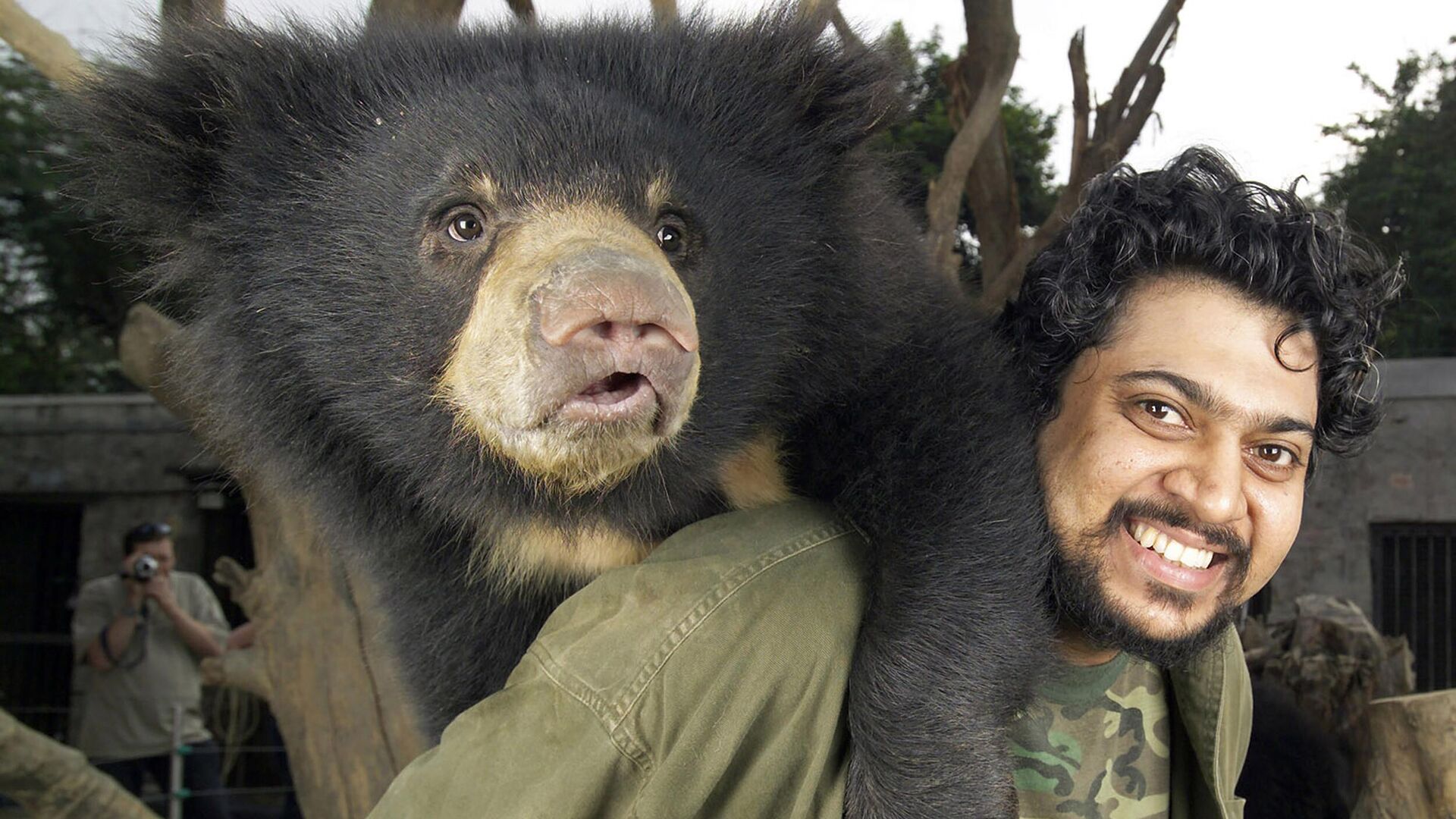https://sputniknews.in/20230528/meet-bear-man-of-india-who-is-on-a-rescue-mission-to-save-wild-animals-2190706.html
Meet ‘Bear Man of India’ Who Is On a Rescue Mission to Save Wild Animals
Meet ‘Bear Man of India’ Who Is On a Rescue Mission to Save Wild Animals
Sputnik India
Kartick Satyanarayan, co-founder and CEO of Wildlife SOS, has played a big role in putting an end to the age-old illegal practice of forcing bears to dance in India.
2023-05-28T15:00+0530
2023-05-28T15:00+0530
2023-05-28T15:00+0530
sputnik exclusives
india
wildlife
environment
animal rights
animal extinction
bears
https://cdn1.img.sputniknews.in/img/07e7/05/1a/2190986_0:0:2500:1407_1920x0_80_0_0_2e0393f5fc1485c58c6aa9c17a90b63a.jpg
Call him “The Bear Man of India” or a savior of wild animals, Kartick Satyanarayan has been on a long mission to save the animals in danger due to human-animal conflict and illegal trafficking and poaching.Satyanarayan developed a deep love for wildlife in his late teenage years, when he volunteered to rescue animals in peril and explored the forests surrounding his home in Bengaluru, Karnataka.From Wildlife Enthusiast to Bear Man of IndiaSatyanarayan started working for the conservation of sloth bears, which are only found in India and Nepal, after he discovered the plight of sloth bears who were subjected to heart-breaking abuse and tortured by the Kalandar community.The Kalandar community was an indigenous nomadic gypsy community who used to live across 13 states in Rajasthan's Tonk city, Andhra Pradesh, Karnataka, Madhya Pradesh, Uttar Pradesh, and others. They would earn a livelihood by making bears dance for people’s entertainment.To eradicate the illegal age-old practice of bear dancing, Satyanarayan co-founded Wildlife SOS along with his friend, Geeta Seshamani, in 1995.Community WorkSatyanarayan, along with his team, visited the villages and explained to the Kalandar community that using bears was not just illegal, but a brutal, barbaric practice.His team started educating the Kalandar community members and empowered people, especially women, with life skills so that they could move away from the exploitation and abuse of bears and create a better life for themselves.“We trained them in carpet weaving, embroidery, jewelry making and also helped them set up small shops to support themselves by selling grocery, food stalls, and other things,” Satyanarayan said.Rehabilitation of BearsUnder their ‘Bear Project’, the Wildlife SOS ended up rescuing over 628 bears from the Kalandar community members.The bears rescued were badly injured and malnourished due to years of neglect and abuse.The community members surrendered the bear that they had in their custody to the forest department, who then handed the animal to the Wildlife SOS which has created four rescue centers in Agra, Uttar Pradesh, Bhopal, Madhya Pradesh state, in Bengaluru , Karnataka, and in West Bengal.Since then, he has been given the name “The Bear Man of India”.As he looks back, he only feels proud to see the impact his work has brought to so many lives as well as the animal kingdom.Saving the WildlifeSatyanarayan went on to establish several wildlife rescue and rehabilitation facilities for tigers, bears, leopards, reptiles, birds, and elephants across India and also ran awareness initiatives.He also heads the Anti-Poaching unit of Wildlife SOS called ‘Forest Watch’ and often goes undercover as a decoy to crack poaching gangs.Satyanarayan was not only awarded for the impact he has brought to society and wildlife conservation but he was also featured in several documentaries and left many others inspired by his work.
india
Sputnik India
feedback.hindi@sputniknews.com
+74956456601
MIA „Rossiya Segodnya“
2023
Sangeeta Yadav
https://cdn1.img.sputniknews.in/img/07e6/0c/0f/110602_0:0:641:640_100x100_80_0_0_c298016a79eb02ef8caa9d1f688c12a5.jpg
Sangeeta Yadav
https://cdn1.img.sputniknews.in/img/07e6/0c/0f/110602_0:0:641:640_100x100_80_0_0_c298016a79eb02ef8caa9d1f688c12a5.jpg
News
en_IN
Sputnik India
feedback.hindi@sputniknews.com
+74956456601
MIA „Rossiya Segodnya“
Sputnik India
feedback.hindi@sputniknews.com
+74956456601
MIA „Rossiya Segodnya“
Sangeeta Yadav
https://cdn1.img.sputniknews.in/img/07e6/0c/0f/110602_0:0:641:640_100x100_80_0_0_c298016a79eb02ef8caa9d1f688c12a5.jpg
the bear man of india, savior of wild animals, kartick satyanarayan wildlife enthusiast, sloth bears, illegal practise of dancing bears in india, plight of sloth bears, bears subjected to abuse and torture by kalandar community, wildlife sos, geeta seshamani, community development work, rehabilitation of sloth bear, kartick satyanarayan, dancing bears in india, dancing bears in south asia, saving bears, animal abuse in india,
the bear man of india, savior of wild animals, kartick satyanarayan wildlife enthusiast, sloth bears, illegal practise of dancing bears in india, plight of sloth bears, bears subjected to abuse and torture by kalandar community, wildlife sos, geeta seshamani, community development work, rehabilitation of sloth bear, kartick satyanarayan, dancing bears in india, dancing bears in south asia, saving bears, animal abuse in india,
Meet ‘Bear Man of India’ Who Is On a Rescue Mission to Save Wild Animals
Kartick Satyanarayan, co-founder and CEO of Wildlife SOS, has played a big role in putting an end to the age-old illegal practice of forcing bears to dance in India.
Call him “The Bear Man of India” or a savior of wild animals, Kartick Satyanarayan has been on a long mission to save the animals in danger due to human-animal conflict and illegal trafficking and poaching.
Satyanarayan developed a deep love for wildlife in his late teenage years, when he volunteered to rescue animals in peril and explored the forests surrounding his home in Bengaluru, Karnataka.
From Wildlife Enthusiast to Bear Man of India
Satyanarayan started working for the conservation of sloth bears, which are only found in India and Nepal, after he discovered the plight of sloth bears who were subjected to heart-breaking abuse and tortured by the Kalandar community.
The Kalandar community was an indigenous nomadic gypsy community who used to live across 13 states in Rajasthan's Tonk city, Andhra Pradesh, Karnataka, Madhya Pradesh, Uttar Pradesh, and others. They would earn a livelihood by making bears dance for people’s entertainment.
“It was really quite heart-breaking. The mother bears will be killed, the baby bears will be taken away by poachers and then sold to this community. They would then use a mechanism to train the bears, which involves using metal rods to break the teeth, using a red-hot iron poker to put a hole through their muzzle and tying them with rope to make them dance on the streets,” Satyanarayan recalled.
To eradicate the illegal age-old practice of bear dancing, Satyanarayan co-founded Wildlife SOS along with his friend, Geeta Seshamani, in 1995.
Satyanarayan, along with his team, visited the villages and explained to the Kalandar community that using bears was not just illegal, but a brutal, barbaric practice.
“This was preventing them from putting down their roots and settling in a place and sending their children to school. All this wasn’t good for them and the social strata,” Satyanarayan said.
His team started educating the Kalandar community members and empowered people, especially women, with life skills so that they could move away from the exploitation and abuse of bears and create a better life for themselves.
“We trained them in carpet weaving, embroidery, jewelry making and also helped them set up small shops to support themselves by selling grocery, food stalls, and other things,” Satyanarayan said.
“We managed to rehabilitate 3,000 families who lived in abject poverty till that time. We gave them rehabilitation support and alternative livelihoods and have sent over 11,000 children to school who didn’t have any access to education,” Satyanarayan added.
Under their ‘Bear Project’, the Wildlife SOS ended up rescuing over 628 bears from the Kalandar community members.
The bears rescued were badly injured and malnourished due to years of neglect and abuse.
“We could only give these bears a lifetime of care in a nice forested sanctuary. These bears lived in large forested enclosures and we were able to give them medical treatment, rehabilitation support, good nutrition, and life close to the wildlife,” Satyanarayan said.
The community members surrendered the bear that they had in their custody to the forest department, who then handed the animal to the Wildlife SOS which has created four rescue centers in Agra, Uttar Pradesh, Bhopal, Madhya Pradesh state, in Bengaluru , Karnataka, and in West Bengal.
Since then, he has been given the name “The Bear Man of India”.
As he looks back, he only feels proud to see the impact his work has brought to so many lives as well as the animal kingdom.
Satyanarayan went on to establish several wildlife rescue and rehabilitation facilities for tigers, bears, leopards, reptiles, birds, and elephants across India and also ran awareness initiatives.
He also heads the Anti-Poaching unit of Wildlife SOS called ‘Forest Watch’ and often goes undercover as a decoy to crack poaching gangs.
Satyanarayan was not only awarded for the impact he has brought to society and wildlife conservation but he was also featured in several documentaries and left many others inspired by his work.




